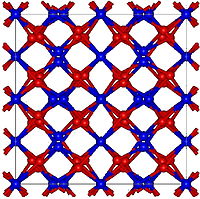
Photo from wikipedia
Four novel ternary phases have been prepared in the system Ca-Li-Sn using both the metal flux method and conventional high-temperature synthesis. Each of the obtained compositions represents its own (new)… Click to show full abstract
Four novel ternary phases have been prepared in the system Ca-Li-Sn using both the metal flux method and conventional high-temperature synthesis. Each of the obtained compositions represents its own (new) structure type, and the structures feature distinct polyanionic Sn units. Ca4LiSn6 (space group Pbcm, Pearson symbol oP44) accommodates infinite chains, made up of cyclopentane-like [Sn5]-rings, which are bridged by Sn atoms. The Sn atoms in this structure are two- and three-bonded. The anionic substructure of Ca9Li6+xSn13-x (x ≈ 0.28, space group C2/m, Pearson symbol mS56) displays extensive mixing of Li and Sn and combination of single-bonded and hypervalent interactions between the Sn atoms. Hypervalent bonding is also pronounced in the structure of the third compound, Ca2LiSn3 (space group Pmm2, Pearson symbol oP18) with quasi-two-dimensional polyanionic subunits and a variety of coordination environments of the Sn atoms. One-dimensional [Sn10]-chains with an intricate topology of cis- and trans-Sn-Sn bonds exist in the structure of Ca9-xLi2Sn10 (x ≈ 0.16, space group C2/m, Pearson symbol mS42), and the Sn-Sn bonding in this case demonstrates the characteristics of an intermediate between single- and double- bond-order. The peculiarities of the bonding are discussed in the context of the Zintl approach, which captures the essence of the main chemical interactions. The electronic structures of all four compounds have also been analyzed in full detail using first-principles calculations.
Journal Title: Dalton transactions
Year Published: 2019
Link to full text (if available)
Share on Social Media: Sign Up to like & get
recommendations!